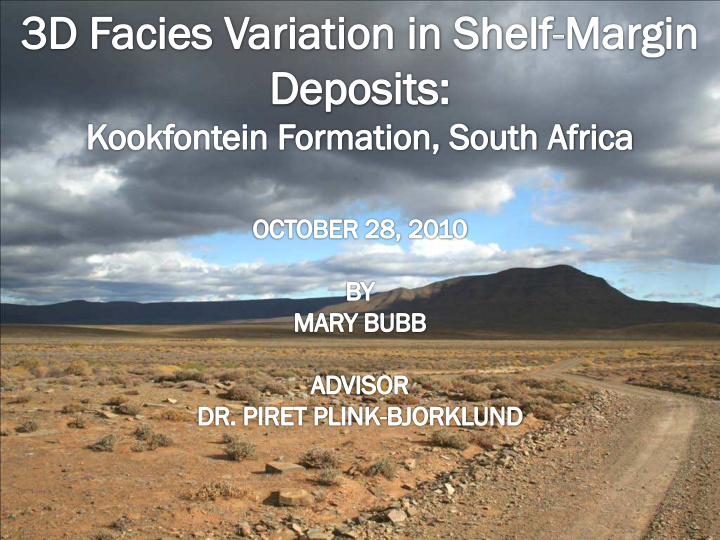



SCIENTIFIC QUESTIONS Q How do facies vary three-dimensionally in shelf- margin systems? Q How do tidal features vary vertically and laterally across shelf-margins?
FIELD AREA N Pienaarsfontein Se Berg Grasberg 8.19 km Meideberg Study Area Measured stratigraphic Cape Town sections are marked with red dots 100 km ( Google Earth and Google Map images)
PREVIOUS WORKS Kookfontein: Wild, 2005 - detailed study of • Unit 5 (deepwater) –regional study of Kookfontein Fm Wild’s cycles C5-C8 correspond • to the Stratigraphic Units 1, 2, and 3 of this study Green, 2009 – up-dip detailed • study of Units 1, 2, and 3 Strat. column(Green, 2009), diagrams (Wild, 2005), photos courtesy of Asle Strom, Statoil
METHODS Followed 3 Units Measured 18 Stratigraphic sections Walked out key surfaces and packages Measured paleocurrents N Unit 0 Unit 3 Unit 2 Unit 1 Unit 0 Top of Josh’s work
CHALLENGES Schedule Coordination and Time Management Language Barriers Semi- Continuous and Weathered Outcrops Rugged Terrain Dangerous Animals www.wildlife-pictures-online.com/200707.html
N Cross Section E W DIP STRIKE DIP Mouth Bars Delta Front Pro Delta Unit 3 Unit 2 Unit 1 17 13 12 7 2 8 9 16 15
PRO DELTA – THINLY- BEDDED SILTSTONES Bioturbation? Tidal Influence Thinly Bedded Turbidites
DELTA FRONT - TURBIDITES Coaly fragments Alternating deformed and un-deformed siltstones and sandstones Decimeter-scale sandstones with rippled tops
DELTA FRONT – ALTERNATING DEFORMED BEDS Slump? Heterolithic deformed bed Alternating deformed and un- deformed siltstone and sandstone Very thinly bedded siltstone
DELTA FRONT - DEFORMED BEDS Slump? Deformed sandstone In Situ deformed sandstone In Situ deformed siltstone Thick turbidite bed
MOUTH BARS Accretion wedge Heterolithic deformed package 1.5 m Concretions Meter-scale sandstone with scour and fill Mouth bar toe with tidal influence
MOUTH BARS Decimeter-scale sandstones with inclined bedding Meter-scale sandstone with concretions Concretions Thick turbidite bed Thinly-bedded turbidites
EVIDENCE FOR TIDAL INFLUENCE Mud Drapes Bidirectional Paleocurrents Heterolithic Sediment Flaser, Lenticular, and Wavy Bedding Double Mud Drapes Reactivation Surfaces
Dominant paleocurrent direction Flaser Bedding Lenticular Bedding Preserved Mud Drapes in In Situ Deformed Sediment Weathered-out Mud Drapes in Thick Sandstones Flaser and Lenticular Bedding in Thinly Mud Drapes in Sandstone Bedded Siltstone
PLANS FOR FUTURE WORK Further define vertical and horizontal facies variability Construct strike and dip cross sections Create block diagrams to further illustrate facies distribution Establish criteria for recognizing shelf-edge facies Compare my findings to work done up-dip Write, Write, Write!!!!!
QUESTIONS?
SHELF-EDGE DELTA MODEL (from Plink-Björklund et al., 2001)
SCIENTIFIC IMPLICATIONS AND CONCLUSIONS Recognition of tidal features can impact reservoir characterization and quality Sediment Morphology
SCIENTIFIC IMPLICATIONS AND CONCLUSIONS Detailed 3D outcrop studies can help characterize shelf-edge delta facies. Understanding shelf –margin facies can help us understand shelf-margin progradation, slope accretion, and their relationship to deep water sands. (Seybold et al., 2007)
m FACIES ASSOCIATIONS Unit 1 Composite Section In Situ Deformed Siltstone and Sandstone Heterolithic Slump Deposit Thinly Bedded Siltstone Thick Sandstones Alternating Deformed or Undeformed Siltstone and Sandstone
CONCLUSIONS Packages are mainly prograding or aggrading Units coarsen-upward Tidal-influence decreases upward
GEOLOGICAL AND STRATIGRAPHIC BACKGROUND Retroarc Foreland Basin Karoo Basin -Tanqua depocenter Kookfontein Formation: ~250 m of stacked coarsening-upward intervals Slope to shelf deltaic deposits ( Compiled and modified from Visser, 1993; Hancox & Rubidge, 2001; Andersson et al., 2004; Gradstein & Ogg, 2004; Wild, 2005; Scheffler et al., 2006; Fildani et al., 2007; Herbert & Compton, 2007;Fildani et al., 2009; Tankard et al., 2009).
m VERTICAL TIDAL DISTRIBUTION Tidal Features Decrease Tidal features can be Unit 1 Composite Section found throughout each Unit Abundance and variety of features decreases upward Thinly-bedded siltstones exhibit the most tidal features
Recommend
More recommend